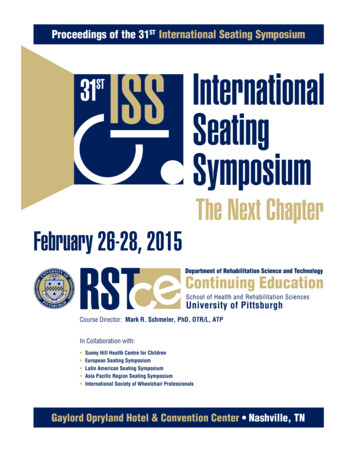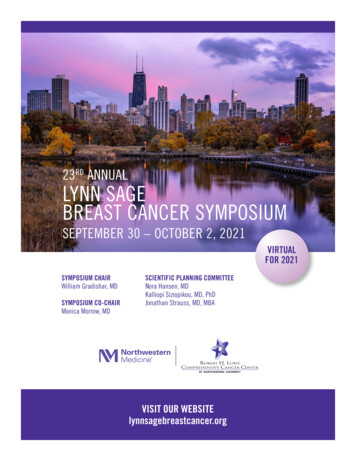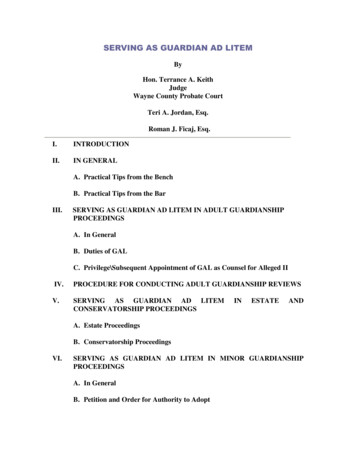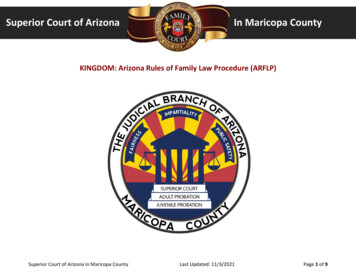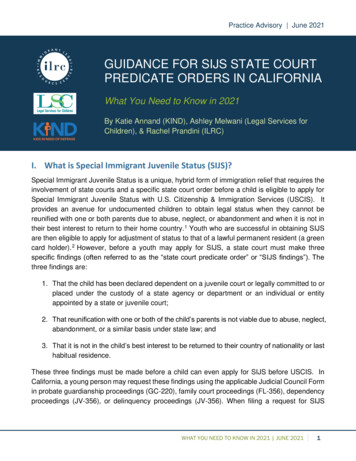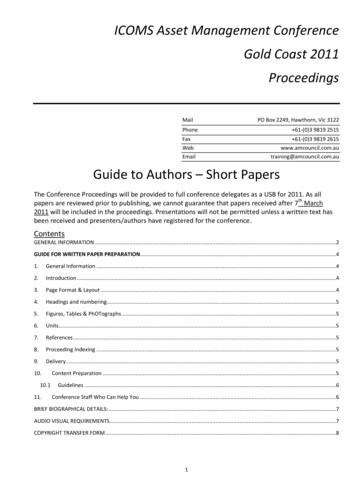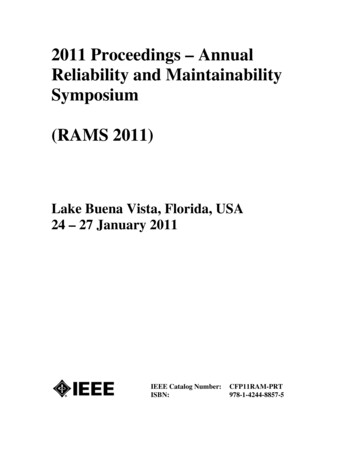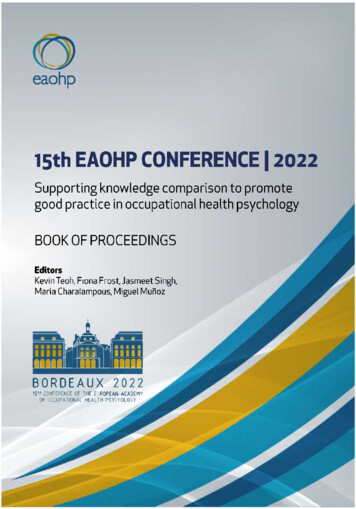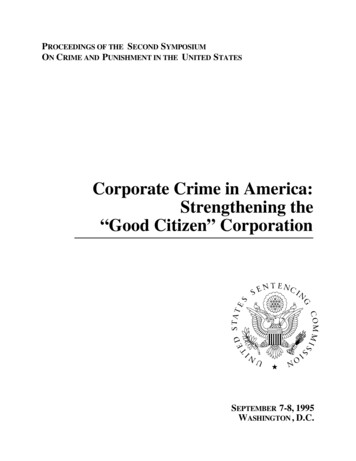
Transcription
PROCEEDINGS OF THE SECOND SYMPOSIUMON CRIME AND PUNISHMENT IN THE UNITED STATESCorporate Crime in America:Strengthening the“Good Citizen” CorporationSEPTEMBER 7-8, 1995WASHINGTON , D.C.
Corporate Crime in America:Strengthening the“Good Citizen” CorporationRichard P. ConaboyChairmanMichael S. GelacakVice ChairmanA. David MazzoneVice ChairmanWayne A. BuddCommissionerJulie E. CarnesCommissionerMichael GoldsmithCommissionerDeanell R. TachaCommissionerMary Frances HarkenriderEx-officioEdward F. Reilly, Jr.Ex-officio
Corporate Crime in America: Strengthening the “Good Citizen” CorporationINTRODUCTIONOn September 7-8, 1995, approximately 450 people gathered in Washington, D.C., forthe U.S. Sentencing Commission’s second symposium on crime and punishment, “CorporateCrime in America: Strengthening the ‘Good Citizen’ Corporation.” The symposium focused onthe ways in which companies, industries, and enforcement officials have responded to theorganizational sentencing guidelines’ “carrot and stick” incentives and other changes in theenforcement landscape that encourage businesses to develop strong compliance programs andadopt crime-controlling measures. Participants included a wide range of federal enforcementofficials, representatives of Fortune 500 as well as smaller corporations, private attorneys andother consultants who advise organizations, and academics who focus on business ethics andcrime.The Sentencing Commission sponsored this second symposium on crime andpunishment in furtherance of its various authorities to collect and disseminate information onsound sentencing policies and practices (see 28 U.S.C. §§ 991-98). The event was co-chairedby Commissioners Wayne A. Budd and Michael Goldsmith.The organizational sentencing guidelines became effective on November 1, 1991. Witha general focus on the organizational guidelines’ policy of tying potential penalties for criminaloffenses to the quality of corporate self-policing efforts, the symposium addressed the followingissues:1.corporate experiences in developing “effective” compliance programs;2.whether the government can (or should) do more to foster “good corporatecitizenship”;3.whether and when compliance practices should be protected from disclosure;4.new models and proposals for evolving compliance standards;5.the role of ethics, incentives, and private inspectors general in achievingcompliance;6.whether and how overlapping enforcement schemes can be coordinated moreeffectively; and7.the views and experiences of the enforcement community on compliance andrelated “good corporate citizenship” issues.The first day began with a welcoming address from Judge Richard P. Conaboy,Chairman of the Sentencing Commission, who stated that at the core of the organizationalguidelines is the notion that “people committed to high ethical standards and carefullyconsidered policies can, in fact, reduce corporate crime.” He added that he hoped thesymposium would “provide a window” on the way in which corporations, industry groups, andiii
U.S. Sentencing Commissiongovernment enforcement personnel are responding to the organizational sentencing guidelines’emphasis on compliance programs and other crime-deterring measures.Two presentations followed that provided participants an overview of theorganizational guidelines’ operation and goals. L. Russell Burress, the SentencingCommission’s Principal Training Advisor, and Julie R. O’Sullivan, Associate Professor,Georgetown University Law Center, discussed the operation of the organizational guidelines’culpability score and other guideline features that combine to provide structured sentencing fororganizations. Win Swenson, the Commission’s Deputy General Counsel, then outlined the“carrot and stick” philosophy that underlies the organizational guidelines. This philosophystrongly encourages the establishment and maintenance of effective compliance plans to preventand detect wrongdoing by providing for substantially reduced penalties for companies that haveundertaken these actions but have nevertheless sustained a criminal conviction.The program next turned to the first of 11 topical panels, each led by a moderator wholaid out the issues to be addressed by the panel, facilitated the transition and interaction betweenthe speakers, and relayed questions submitted by the audience. (Panel moderators were JeffreyM. Kaplan of Arkin, Schaffer & Supino, and Commissioner Wayne A. Budd, Mary E. Didier,Marguerite A. Driessen, Donald A. Purdy, and Win Swenson of the Sentencing Commission).The first panel, consisting of Kenneth D. Martin of Sundstrand Corporation, Herbert L.Thornhill of the Bank of Tokyo, and John A. Meyers formerly of Tenet Healthcare Corporation,discussed experiences with compliance programs in the defense and general manufacturing,financial services, and health care industries, respectively.Sundstrand established a government contracts-oriented compliance program in the1980s after being prosecuted for billing irregularities and at a time when the defense industrygenerally was instituting compliance-related reforms. When the organizational guidelines werepromulgated, Sundstrand expanded its compliance efforts to cover its commercial business andadopted an innovative “responsible executive” program in which an executive withresponsibility for a specific compliance area (e.g., antitrust, environment, copyright) reportsdirectly to the highest echelon of the company on a wide range of compliance issues relating tothat area. The Bank of Tokyo responded to a climate influenced by the savings and loan crisisand new regulatory demands by instituting an integrated compliance structure based on thesentencing guidelines. After a major government investigation focused on one of its multiplebusinesses, Tenet Healthcare, formerly National Medical Enterprises, was required to establishcostly and demanding compliance practices, some of which might have been avoided had thecompany been able to establish company-wide the significant compliance measures it hadadopted in other sections of the company.The next panel discussed the sharing of “best practices” information within fourassociations formed in large part for this information-sharing purpose. Members on the panelwere Howrey & Simon attorney Alan R. Yuspeh, the coordinator of the Defense IndustryInitiative on Business Ethics and Conduct, W. Michael Hoffman of the Ethics OfficerAssociation, Thomas Furtado of United Technologies representing the Ombudsman’sAssociation, and Anne L. Gill from Sprint who described the Telecommunications IndustryCompliance Practices Forum.iv
Corporate Crime in America: Strengthening the “Good Citizen” CorporationThe first day’s luncheon keynote address was given by Senator Edward M. Kennedy(D-Mass.), one of the principal architects of the Sentencing Reform Act that created theSentencing Commission. Senator Kennedy discussed how the organizational guidelines broughtgreater rationality to federal enforcement of corporate crime. This system, he said, had beencharacterized by “law without order,” with penalties largely dependent on the views ofindividual judges. He emphasized that corporate crime is not “an overblown, anti-businessinvention of career-hungry prosecutors, regulators, and politicians,” but is “both serious anddistressingly common.” In this regard, he praised the “serious commitment to compliance” thatsome companies are making.Senator Kennedy added that government enforcement personnel must attempt tounderstand better what an effective compliance plan entails, and to coordinate criminal, civil,and administrative penalties to make federal policy more effective. He recommended that smallbusinesses be given a fair opportunity to develop effective compliance plans as well.The first afternoon panel presented the results of empirical research on compliancepractices – cataloging what compliance practices companies are undertaking and shedding lighton the differences between what companies believe they are doing and what employees actuallyperceive. The first three panelists presented results from Commission-sponsored studies:Andrew R. Apel of the Minnesota Association for Applied Corporate Ethics presentedpreliminary results from a national study of compliance practices; William S. Laufer of theWharton School of Business presented the preliminary results of a study of small businesscompliance practices; and Edward S. Petry of the Center for Business Ethics presentedpreliminary results from a study of compliance practices in “compliance aware” companies.The remaining two panelists were Rebecca Goodell of Howery & Simon, and Mark Pastin of theCouncil of Ethical Organizations. These two panelists described, respectively, the EthicsResource Center’s survey of ethics practices and employee perceptions, and the Council ofEthical Organizations’s study of organizational factors and their effect on compliance.The first day’s program concluded with two breakout sessions. One breakout sessionwas devoted to new models and proposals for compliance standards. Edward A. Dauer,President of the National Center for Preventive Law, discussed his organization’s efforts todevelop standards for corporate compliance. James T. Banks, Director of Governmental andEnvironmental Affairs for WMX Technologies, Inc., presented the compliance plan designed bythe Advisory Working Group on Environmental Sanctions. Christopher L. Bell, a member ofthe U.S. delegation to the Organization for International Standardization’s internationalenvironmental standards initiative (“ISO 14000”), discussed the development and implicationsof environmental quality standards in the global arena.The second breakout session began with a presentation by Commission Staff AssistantMary E. Didier on the flexibility of the guidelines’ approach to defining “effective” compliancestrategies. Ronald Goldstock of Kroll Associates then discussed the value of using an“Independent Private Sector Inspector General” in fostering effective, credible complianceprograms within organizations. Gary Edwards of the Ethics Resource Center discussed theprincipal causes of serious misconduct in organizations. He emphasized that a particularlyproblematic root cause of corporate misconduct involves employees who come to believev
U.S. Sentencing Commissionmistakenly that management expects them to cut legal corners.The second day of the symposium began with a panel presenting empirical data onorganizational cases. Commission Research Associate John Scalia, Jr., discussed casessentenced to date under the guidelines, and Kirk S. Jordan of Compliance Systems Legal Groupdiscussed criteria in consent decrees.The next two panels examined the interaction between the enforcement community andthose subject to enforcement. The first of these panels consisted of Eleanor Hill, the InspectorGeneral at the Defense Department, William B. Lytton of Lockheed Martin Corporation, andDavid N. Yellen of Hofstra University Law School. Ms. Hill discussed the successes of theDefense Department’s Voluntary Disclosure Program. Mr. Lytton discussed the seeming lackof coordination in federal enforcement and noted that overlapping enforcement policies can sendinconsistent or even conflicting messages to organizations. Professor Yellen explored the waysin which inconsistent policies can undercut strong compliance and suggested possible reforms.The next panel was comprised of senior Justice Department officials who detailed theirapproaches to enforcement, especially with respect to compliance programs. Panelists were:Robert S. Litt, Deputy Assistant Attorney General in the Criminal Division, Ronald A.Sarachan, Chief of the Environmental Crimes Section of the Environment and NaturalResources Division, Gary R. Spratling, Deputy Assistant Attorney General in the AntitrustDivision, and Eugene M. Thirolf, Director of the Office of Consumer Litigation in the CivilDivision. The panel was moderated by Commissioner Wayne A. Budd, formerly AssociateAttorney General of the United States.The luncheon keynote address on the second day was given by Stephen L. Hammerman,Vice Chairman of the Board of Merrill Lynch & Company, Inc. Mr. Hammerman said that thesecurities industry generally believes that good compliance is “good business,” noting that anattack on a corporation’s reputation in the securities industry will cause an important lack ofconfidence both in the company and the capital markets. In his view, however, managementmust set the tone for how employees are to behave. He emphasized that while the generalcounsel should participate in correcting any wrongdoing, the highest executive in the businessunit “bears the primary responsibility for taking compliance action and [for reacting] if one oftheir people does not adhere to good compliance standards.” Mr. Hammerman stated that aneffective compliance program requires a consistent and sincere effort at education that involvesthe active participation of senior officials.The first afternoon panel updated the status of legal privileges and their relationship tocompliance practices. Commissioner Michael Goldsmith of the Sentencing Commissiondiscussed the relationship of privilege to the organizational guidelines’ carrot and stick features.After canvassing current law, Commissioner Goldsmith observed that the compliance practicescontemplated by the guidelines do pose some disclosure and liability risks. He discussed thepossible implications of these risks and ways practitioners may respond to them. PatriciaBangert, Deputy Attorney General for National Resources in Colorado, discussed recentlyenacted legislation in Colorado designed to respond to these risks – at least in the environmentalarea – by 1) giving privileged status to self-evaluative audits that companies performvi
Corporate Crime in America: Strengthening the “Good Citizen” Corporationvoluntarily in administrative, civil, and criminal contexts; and 2), giving immunity to a companythat performs a voluntary audit, discloses to authorities any violations found by that audit, andcorrects the violations.The ideal role of government in fostering “good corporate citizenship” was the subjectof the next panel, featuring two perspectives on enforcement and compliance assurance. StevenA. Herman, the top enforcement official at the Environmental Protection Agency (EPA),discussed a variety of programs and approaches EPA has undertaken to foster good corporatecitizenship in the environmental area.Joseph E. Murphy of Bell Atlantic recommended that government enforcement officialslearn more about the practicalities of establishing compliance and ethics programs. He stressedthe need for more incentives from government to reward innovative, compliance-supportingcorporate actions. He expressed concern, for example, that voluntary disclosure can causecompanies more negative consequences than positive.The final panel was comprised of four experts of diverse backgrounds who faced thechallenging task of describing what they found to be the most important themes and issues – forboth the business community and government – raised during the course of the conference. Thefinal panelists were: Neal S. Cartusciello of Shanley & Fisher, Janet C. Cook, from the U.S.Air Force, Richard S. Gruner of the Whittier Law School, and Lynn Sharp Paine from theHarvard Business School.This proceedings book attempts to capture the flavor and substance of the symposium.In addition to reproducing presentations by symposium speakers, the book includes responses toquestions that were submitted to speakers, but to which time did not permit answers during theprogram itself, as well as an analysis of ideas and issues that symposium attendees found mostsignificant.1The Commission will continue to monitor sentencing practices for organizationaldefendants, amend the guidelines as experience warrants, and encourage organizationalguideline training. In addition, the Commission will communicate with the private sector,business and law schools, and other interested parties to promote a more ethical, law-abidingcorporate culture, and will work with law enforcement on issues concerning consistent, effectiveenforcement policies.1Because of space considerations, not all overheads used at the symposium are included in this volume.vii
U.S. Sentencing CommissionChairman Richard P. Conaboy and Senator Edward M. Kennedy, flanked by symposiumchairs Commissioner Wayne A. Budd (front left) and Commissioner Michael Goldsmith(front right), pause briefly following Senator Kennedy’s keynote address to a capacitycrowd. In the background, Senator Kennedy’s Chief Counsel Ronald Weich (back left)and symposium coordinator Win Swenson, the Commission’s Deputy General Counsel(back right), look on.Photo 1995 by MH Photography .viii
Corporate Crime in America: Strengthening the “Good Citizen” CorporationINTRODUCTIONOn September 7-8, 1995, approximately 450 people gathered in Washington, D.C., forthe U.S. Sentencing Commission’s second symposium on crime and punishment, “CorporateCrime in America: Strengthening the ‘Good Citizen’ Corporation.” The symposium focused onthe ways in which companies, industries, and enforcement officials have responded to theorganizational sentencing guidelines’ “carrot and stick” incentives and other changes in theenforcement landscape that encourage businesses to develop strong compliance programs andadopt crime-controlling measures. Participants included a wide range of federal enforcementofficials, representatives of Fortune 500 as well as smaller corporations, private attorneys andother consultants who advise organizations, and academics who focus on business ethics andcrime.The Sentencing Commission sponsored this second symposium on crime andpunishment in furtherance of its various authorities to collect and disseminate information onsound sentencing policies and practices (see 28 U.S.C. §§ 991-98). The event was co-chairedby Commissioners Wayne A. Budd and Michael Goldsmith.The organizational sentencing guidelines became effective on November 1, 1991. Witha general focus on the organizational guidelines’ policy of tying potential penalties for criminaloffenses to the quality of corporate self-policing efforts, the symposium addressed the followingissues:1.corporate experiences in developing “effective” compliance programs;2.whether the government can (or should) do more to foster “good corporatecitizenship”;3.whether and when compliance practices should be protected from disclosure;4.new models and proposals for evolving compliance standards;5.the role of ethics, incentives, and private inspectors general in achievingcompliance;6.whether and how overlapping enforcement schemes can be coordinated moreeffectively; and7.the views and experiences of the enforcement community on compliance andrelated “good corporate citizenship” issues.The first day began with a welcoming address from Judge Richard P. Conaboy,Chairman of the Sentencing Commission, who stated that at the core of the organizationalguidelines is the notion that “people committed to high ethical standards and carefullyconsidered policies can, in fact, reduce corporate crime.” He added that he hoped thesymposium would “provide a window” on the way in which corporations, industry groups, and1
U.S. Sentencing Commissiongovernment enforcement personnel are responding to the organizational sentencing guidelines’emphasis on compliance programs and other crime-deterring measures.Two presentations followed that provided participants an overview of theorganizational guidelines’ operation and goals. L. Russell Burress, the SentencingCommission’s Principal Training Advisor, and Julie R. O’Sullivan, Associate Professor,Georgetown University Law Center, discussed the operation of the organizational guidelines’culpability score and other guideline features that combine to provide structured sentencing fororganizations. Win Swenson, the Commission’s Deputy General Counsel, then outlined the“carrot and stick” philosophy that underlies the organizational guidelines. This philosophystrongly encourages the establishment and maintenance of effective compliance plans to preventand detect wrongdoing by providing for substantially reduced penalties for companies that haveundertaken these actions but have nevertheless sustained a criminal conviction.The program next turned to the first of 11 topical panels, each led by a moderator wholaid out the issues to be addressed by the panel, facilitated the transition and interaction betweenthe speakers, and relayed questions submitted by the audience. (Panel moderators were JeffreyM. Kaplan of Arkin, Schaffer & Supino, and Commissioner Wayne A. Budd, Mary E. Didier,Marguerite A. Driessen, Donald A. Purdy, and Win Swenson of the Sentencing Commission).The first panel, consisting of Kenneth D. Martin of Sundstrand Corporation, Herbert L.Thornhill of the Bank of Tokyo, and John A. Meyers formerly of Tenet Healthcare Corporation,discussed experiences with compliance programs in the defense and general manufacturing,financial services, and health care industries, respectively.Sundstrand established a government contracts-oriented compliance program in the1980s after being prosecuted for billing irregularities and at a time when the defense industrygenerally was instituting compliance-related reforms. When the organizational guidelines werepromulgated, Sundstrand expanded its compliance efforts to cover its commercial business andadopted an innovative “responsible executive” program in which an executive withresponsibility for a specific compliance area (e.g., antitrust, environment, copyright) reportsdirectly to the highest echelon of the company on a wide range of compliance issues relating tothat area. The Bank of Tokyo responded to a climate influenced by the savings and loan crisisand new regulatory demands by instituting an integrated compliance structure based on thesentencing guidelines. After a major government investigation focused on one of its multiplebusinesses, Tenet Healthcare, formerly National Medical Enterprises, was required to establishcostly and demanding compliance practices, some of which might have been avoided had thecompany been able to establish company-wide the significant compliance measures it hadadopted in other sections of the company.The next panel discussed the sharing of “best practices” information within fourassociations formed in large part for this information-sharing purpose. Members on the panelwere Howrey & Simon attorney Alan R. Yuspeh, the coordinator of the Defense IndustryInitiative on Business Ethics and Conduct, W. Michael Hoffman of the Ethics OfficerAssociation, Thomas Furtado of United Technologies representing the Ombudsman’sAssociation, and Anne L. Gill from Sprint who described the Telecommunications IndustryCompliance Practices Forum.2
Corporate Crime in America: Strengthening the “Good Citizen” CorporationThe first day’s luncheon keynote address was given by Senator Edward M. Kennedy(D-Mass.), one of the principal architects of the Sentencing Reform Act that created theSentencing Commission. Senator Kennedy discussed how the organizational guidelines broughtgreater rationality to federal enforcement of corporate crime. This system, he said, had beencharacterized by “law without order,” with penalties largely dependent on the views ofindividual judges. He emphasized that corporate crime is not “an overblown, anti-businessinvention of career-hungry prosecutors, regulators, and politicians,” but is “both serious anddistressingly common.” In this regard, he praised the “serious commitment to compliance” thatsome companies are making.Senator Kennedy added that government enforcement personnel must attempt tounderstand better what an effective compliance plan entails, and to coordinate criminal, civil,and administrative penalties to make federal policy more effective. He recommended that smallbusinesses be given a fair opportunity to develop effective compliance plans as well.The first afternoon panel presented the results of empirical research on compliancepractices – cataloging what compliance practices companies are undertaking and shedding lighton the differences between what companies believe they are doing and what employees actuallyperceive. The first three panelists presented results from Commission-sponsored studies:Andrew R. Apel of the Minnesota Association for Applied Corporate Ethics presentedpreliminary results from a national study of compliance practices; William S. Laufer of theWharton School of Business presented the preliminary results of a study of small businesscompliance practices; and Edward S. Petry of the Center for Business Ethics presentedpreliminary results from a study of compliance practices in “compliance aware” companies.The remaining two panelists were Rebecca Goodell of Howery & Simon, and Mark Pastin of theCouncil of Ethical Organizations. These two panelists described, respectively, the EthicsResource Center’s survey of ethics practices and employee perceptions, and the Council ofEthical Organizations’s study of organizational factors and their effect on compliance.The first day’s program concluded with two breakout sessions. One breakout sessionwas devoted to new models and proposals for compliance standards. Edward A. Dauer,President of the National Center for Preventive Law, discussed his organization’s efforts todevelop standards for corporate compliance. James T. Banks, Director of Governmental andEnvironmental Affairs for WMX Technologies, Inc., presented the compliance plan designed bythe Advisory Working Group on Environmental Sanctions. Christopher L. Bell, a member ofthe U.S. delegation to the Organization for International Standardization’s internationalenvironmental standards initiative (“ISO 14000”), discussed the development and implicationsof environmental quality standards in the global arena.The second breakout session began with a presentation by Commission Staff AssistantMary E. Didier on the flexibility of the guidelines’ approach to defining “effective” compliancestrategies. Ronald Goldstock of Kroll Associates then discussed the value of using an“Independent Private Sector Inspector General” in fostering effective, credible complianceprograms within organizations. Gary Edwards of the Ethics Resource Center discussed theprincipal causes of serious misconduct in organizations. He emphasized that a particularlyproblematic root cause of corporate misconduct involves employees who come to believe3
U.S. Sentencing Commissionmistakenly that management expects them to cut legal corners.The second day of the symposium began with a panel presenting empirical data onorganizational cases. Commission Research Associate John Scalia, Jr., discussed casessentenced to date under the guidelines, and Kirk S. Jordan of Compliance Systems Legal Groupdiscussed criteria in consent decrees.The next two panels examined the interaction between the enforcement community andthose subject to enforcement. The first of these panels consisted of Eleanor Hill, the InspectorGeneral at the Defense Department, William B. Lytton of Lockheed Martin Corporation, andDavid N. Yellen of Hofstra University Law School. Ms. Hill discussed the successes of theDefense Department’s Voluntary Disclosure Program. Mr. Lytton discussed the seeming lackof coordination in federal enforcement and noted that overlapping enforcement policies can sendinconsistent or even conflicting messages to organizations. Professor Yellen explored the waysin which inconsistent policies can undercut strong compliance and suggested possible reforms.The next panel was comprised of senior Justice Department officials who detailed theirapproaches to enforcement, especially with respect to compliance programs. Panelists were:Robert S. Litt, Deputy Assistant Attorney General in the Criminal Division, Ronald A.Sarachan, Chief of the Environmental Crimes Section of the Environment and NaturalResources Division, Gary R. Spratling, Deputy Assistant Attorney General in the AntitrustDivision, and Eugene M. Thirolf, Director of the Office of Consumer Litigation in the CivilDivision. The panel was moderated by Commissioner Wayne A. Budd, formerly AssociateAttorney General of the United States.The luncheon keynote address on the second day was given by Stephen L. Hammerman,Vice Chairman of the Board of Merrill Lynch & Company, Inc. Mr. Hammerman said that thesecurities industry generally believes that good compliance is “good business,” noting that anattack on a corporation’s reputation in the securities industry will cause an important lack ofconfidence both in the company and the capital markets. In his view, however, managementmust set the tone for how employees are to behave. He emphasized that while the generalcounsel should participate in correcting any wrongdoing, the highest executive in the businessunit “bears the primary responsibility for taking compliance action and [for reacting] if one oftheir people does not adhere to good compliance standards.” Mr. Hammerman stated that aneffective compliance program requires a consistent and sincere effort at education that involvesthe active participation of senior officials.The first afternoon panel updated the status of legal privileges and their relationship tocompliance practices. Commissioner Michael Goldsmith of the Sentencing Commissiondiscussed the relationship of privilege to the organizational guidelines’ carrot and stick features.After canvassing current law, Commissioner Goldsmith observed that the compliance practicescontemplated by the guidelines do pose some disclosure and liability risks. He discussed thepossible implications of these risks and ways practitioners may respond to them. PatriciaBangert, Deputy Attorney General for National Resources in Colorado, discussed recentlyenacted legislation in Colorado designed to respond t
4. new models and proposals for evolving compliance standards; 5. the role of ethics, incentives, and private inspectors general in achieving compliance; 6. whether and how overlapping enforcement schemes can be coordinated more effectively; and 7. the views and experiences of the enforcement community on compliance and



